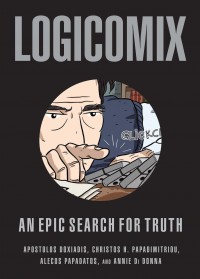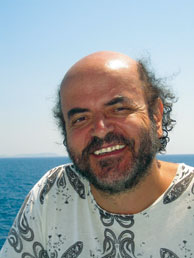HOST INTRO:
I’m Shelley Schlender. This is a story about how telling more stories might encourage more children to get excited about math and science. It begins when a book arrived at KGNU titled, Logicomix: An Epic Search For Truth, with a request for us to interview the author on our science show. Logicomix, though, did not look like a science book. It seemed more like a Tin Tin adventure – you know, the comic books about a boy named Tin Tin, his little dog Snowy, and Captain Haddock who likes to yell, “Blistering Barnacles.” Logicomix looked so UN-like a science book, I decided to check it out with some experts on Tin Tin books. They’re 10-year old twins, named Nora and Lee. I was going to ask them to read Logicomix then tell me what they think. It turns out that Nora and Lee had already read it, two years ago . . . when they were eight. And Nora’s favorite quote from Logicomix sounded, well, scientific.
NORA: Contrawise, if it was so, it might be. And if it were so, it would be, but as it isn’t, it ain’t. That’s logic.
The last bit Nora said is as something isn’t it ain’t. That’s logic, and that is a scientific way to look at things. Nora’s a bit hard to hear right there because her dad is busy setting up a way to record on his computer. We’ll explain why in a minute, but first, here’s 10-year old Lee’s choice from that cartoon book, Logicomix.
As for Lee’s choice . . .
LEE: Here’s my favorite quote in the book. What possessed you until now!!! ?
After Lee said, “What possessed you until now?” Lee’s dad asked him to elaborate . .
CHASE: Says who?
LEE: Alfred Norris White Head. Because he and Russell had a falling out.
It turned out that Lee was referring to a full-page spread in Logicomix of two men yelling at each other, along with cartoon bubble narration, that indicates one of those guys is a 20th century mathematician named Whitehead and the other guy is someone named Bertie. “Bertie” it turns out, was another mathematician. In fact, he was a famous math logician. His full name was Bertrand Russell. Here’s Russell in a 1959 BBC interview about what he would like future generations to know.
RUSSELLL Never let yourself be diverted either by what you wish to believe or by what you think would have beneficint social effects if it were Believed. But look only and solely at what are the facts.
In 1950, Russell had won a Nobel Prize . . . for literature. By 1957, he seemed a gentle grandfatherly guy, and his writing was often political, inspiring, and popular. Logicomix spans six decades of Russell’s life, including an earlier time in Russell’s youth, when he and Whitehead were writing Principia Mathematica. Legend has it that the first 100 pages of the Principia are devoted to proving that 1 plus 1 does indeed, equal 2. From reading Logicomix, Nora agreed with her brother that writing all that made Whitehead and Russell cranky.
NORA: They’ve been working so hard, and Russell’s been re-examining the basis of everything they know. And trying to prove it even though it’s already been proved a million times. And Whitehead’s just so mad that he hasn’t given any care to Eric, since he could barely count to three!
Eric by the way, was Whitehead’s son, and it troubled Nora to read how Whitehead neglected him. As you can see, Nora and Lee really do know a lot about Logicomix, whose topic is science, and the lives of scientists. So we accepted the invitation from Logicomix to interview its authors on the KGNU science show. With a twist. We asked if the twins could do the interview. One of the authors said yes. His name is Christos Papidimitrou, and as we checked him out, we learned that among academics, he’s famous for his textbook on Computational Complexity. Christos is one of the world’s great leaders in math and computer science. Since Nora and Lee live in St. Paul and Christos teaches at UC Berkeley, we arranged to do the interview on computer, via Skype, with the help of Nora and Lee’s dad. Before it began, the big question for the 10-year olds was, should Nora and Lee conduct the interview together?
NORA: I think one after another would work best.
LEE: Yes! Me first! And then Nora next.
SHELLEY: Are you okay with that, Nora?
NORA: Yep. I’m fine.
CHASE: I think he’s ready. So Nora’s first.
NORA: No wait!
CHASE: Lee’s first. Nora, don’t get nervous!
LEE: Where’s my notes.
CHASE: I’ll hand you, and in a moment, I’ll be able to introduce you.
COMPUTER BEEP
SHELLEY – Suddenly the computer displayed the grinning, black-bearded face of Christos Papidimitriou and we heard his Greek-accented hello.
CHRISTOS: Hello.
LEE: My name is Aamon Lee Byrne Turner.
CHRISTOS: Sorry. You have to spell it for me.
LEE: Lee. L-e-e. I have some questions.
CHRISTOS: I’m sure you do.
LEE: Why did Bertie have the revelation that he was a logician in the hat shop.
CHRISTOS: In the ???
LEE: Hat shop
CHRISTOS: Oh, in the hat shop! Of course. Have you read Alice and Wonderland?
Christos told Lee that in Logicomix, they depicted Russell realizing that he’s a logician in a hat shop as an homage to “The Mad Hatter.” After all, in those days, madness was common among logicians. That included in the extended family of Bertie — that is, of Bertrand Russell. Russell had a sad and lonely childhood, with sometimes terrible parenting. On the other hand, Russell found comfort against the sadness in his childhood by studying logic and geometry, and these became his career. All this is in Logicomix, and some of it had worried Lee, who took a big breath and asked Christos this.
LEE: So anyway, I’ve heard that his family had a manifestation of mental illness, and it came in his uncle.
CHRISTOS: Exactly.
LEE: Yep!
CHRISTOS: And this memory, of the uncle, haunted him the rest of his life. He was afraid he was going that way.
LEE: That’s an interesting fact about Berti’s life.
CHRISTOS: But he didn’t.
LEE: Oh.
CHRISTOS: But unfortunately, his son did, which is tragic, also.
They talked some more about how some of the people in the book were better mathematicians than they were parents.
CHRISTOS: Yes. Yeah. So, you can be a very clever man and not understand humans very well, and not understand how even the people you love most feel.
Lee had used a lot of courage to ask these questions. So the next thing he said was this.
LEE: Yep. . . . Anyway, goodbye.
LAUGHTER . . .
CHRISTOS: Wait, come back. . . Let me ask you.
LEE: Yes?
CHRISTOS: Do . . . do you like math at school.
LEE: Yeah, I like math. I do subtraction.
CHRISTOS: Wow! You do subtraction. What grade are you?
LEE: 5th?
CHRISTOS: I’m really curious about how the book attracted your attention so much. What was the reason, you think? I know you are doing the interview, but I thought I should ask this question.
LEE: I like the paradox the best.
CHRISTOS: Wow. Okay. Okay.
NARRATION – Now, Logicomix is all done with Tin-Tin like drawings and cartoon balloons, but it’s full of stuff like Russell’s paradox. which was one of the earliest mathematical explanations about why a set of things cannot reference itself. In Logicomix, the paradox goes like this – What if a village decrees that the barber shaves only those men in town who do not shave themselves. That may sound like an okay law . . . But then, who shaves the barber?
LEE: It’s something about a village with a strict law on shaving, that every male has to shave daily. But for the ones who don’t shave, there’s a barber. And a man of a higher rank can be shaved by the man of a lower rank, can be shaved by a man of a lower rank, can be shaved by a man of a lower rank. Which gets a bunch of hairy low rank guys.
CHRISTOS: Right.
LEE: I think it’s just funny.
CHRISTOS: Thank you. That’s actually a great compliment.
LEE: Thank you! You’re welcome, I mean.
After that, the conversation between 10-year old Lee and the world-renowned complexity theorist, Christos, delved even further into Logicomix.
OPT OUT?
LEE
Why did Bertie have a dream that he would wreck the foundations of mathematics.
Christos replied that while the English Logician “Bertrand Russell worried about wrecking the foundations of mathematics, in a way, another younger logician from Germany ultimately did, by challenging the popular concepts in the early 1900s that assumed math would provide definite answers for everything . . .
CHRISTOS
This youngster Godel in Vienna, he did wreck the foundations of mathematics.
(FADE IN)
LEE
Interesting.
CHRISTOS
Thank you.
OPT IN?
LEE
Why did the publishers refuse to print the Principals of Mathematica.
CHRISTOS
That was a really low point in the book. Wasn’t it?
LEE
Yeah.
CHRISTOS
Very humiliating. You can imagine.
They talked about how the Principlia was so complicated, at first, Whitehead and Russell couldn’t find anyone to read it, not even for pay.
LEE
That’s Interesting. Anyway, what inspired you to write this book.
Christos explained that the ideas that Bertrand Russell pushed ahead in the Principia Mathematica laid the foundations for people like Godel to make further contributions to what’s near and dear to Christos’s heart. Computers, and computer science.
CHRISTOS
All my life I admire these people. It’s always fascinating to me, when somebody dedicates their life to do something hard that nobody else have dared try before. These people that we wrote about were legends. We were very attracted to the story. But also, we sort of tried to explain the dawning of the computer era because out of this investigation, failed as it was, the computer started. 10 years after the end of the action in Logicomix. The computer came out of the ashes of the 2nd World War.
LEE
Anyway, I myself think that the end is kind of weird about the play called the Orchestra.
REMOVE MUSIC at 10:00
Lee was correct, that Logicomix ends with a classic Greek Play about a young man who tries to obey the Gods, gets caught in a double-bind, and is tormented by howling goddesses called the Furies. The play shows the transformation of madness and fury into wisdom, That happens to be what Bertrand Russell strived for throughout his life. And that’s an interesting layer of Logicomix. And how to turn things like sadness and rage into something marvelous. However, that Greek play that Lee called The Orchestra actually has a different name.
CHRISTOS
Orestia!
LEE
Yep. Orestia.
CHRISTOS
It is a little weird isn’t it
LEE
Yep.
CHRISTOS
It’s a fascinating story. Maybe some day you’ll read it all. It’s not a big play. Some people consider it one of the two greatest plays ever written. You know what the other one is?
Lee was wondering about something else. It was the Logicomix cartoons depicting the furies.
LEE
I think it has some sort of wild cats and Athena the goddess of wisdom in it.
CHRISTOS
Yeah, right. The wildcats are a way of presenting some goddesses.
LEE
Oh.
CHRISTOS
Old women who were chasing the people who did the bad things.
LEE
Interesting. (WHISPER – Nora, it’s your turn.) Anyway, I’m turning over the narration to my sister, Nora Elizabeth Byrne Turner.
NORA
Thank you.
LEE
You’re welcome.
CHRISTOS
Hello, Nora.
NORA
Hi, it’s nice to meet you. What happened to Russell’s friend Moore? He just disappeared and reappears. What happens in the times he disappeared.
CHRISTOS
He became a very important mathematician philosophy logician. Except we didn’t find meaningful ways to engage him further in the story. You liked especially Moore?
NORA
Yeah, he seemed like a pretty nice guy. Why do you think Russell wrote the Principia Mathematics with so many proofs, and then wrote it all over again, and yeah.
CHRISTOS
The way to say it is this. Old Euclid had been able to set complete order in the house of geometry. So you have four little facts that everyone agrees upon in geometry. On these four facts you can build all of geometry. His ambition was to do the same with mathematics. Since geometry gave him such comfort in his childhood, the comfort of knowing something for sure, he wanted to do the same for all of mathematics. He wanted. to be the next Euclid. That was a tremendous undertaking. He worked day and night, and of course, he needed all the help he could have to do it. That’s why he engaged his teacher, Whitehead.
Christos and Nora talked a long while about the people Bertrand Russell met, the poetry he liked, where he traveled. Then finally Nora shrugged her shoulders.
NORA
I’m out of questions.
CHRISTOS
You’ve had a lot of questions. You’ve asked beautiful questions.
As for why a great computational complexity expert such as Christos Papidimirtiou enjoyed being interviewed by 10 year olds, he later talked about it with a young physicist named Amory, who lives near UC Berkeley. Amory is the older cousin of Nora and Lee.
AMORY
You talked with Aamon Lee Turner and his twin sister Nora. Were you surprised that kids that young had been reading your book?
CHRISTOS
So what I remember is that I was stunned by how well and deeply they understood what was written. And also I was surprised at the new ways they interpreted it.
Christos added that these days, educators do most of their teaching with textbooks such as his famous, Computational Complexity. He’s well known for that, but he spent eight years creating Logicomix because he thinks it also matters to tell stories.
CHRISTOS
Unfortunately we don’t use stories. This university and schools and so on, is a rather recent experiment. What, 1,000 years old? Before that, all the information was communicated through stories.
AMORY
Some kids are looking for heroes that match them. Little boys that are good at sports like sport starts. But kids that are more attracted to say math, you don’t find a lot of heroes. Was that part of your . . .
CHRISTOS
Yes. I hope to plant the seed in some young person’s mind that it is possible to choose the quest beyond yourself. Artificial intelligence. I just wanted to show there’s a universe where people don’t forget this little incremental game. They confront basic, important problem and change the world.
And so I assume you haven’t read Principia Mathematics?
I have leafed through it many times. It’s evidence of something historic.
Back in St. Paul, before the 10-year olds had signed off with Christos, their dad had mentioned an idea that Nora got from a little drawing on page 92 of Logicomix that seemed to indicate A plus A can sometimes equal A.
CHRISTOS
Did you tell me that Nora solves this equation, A plus A equals zero?
CHASE
She was mentioning it in the car and said it was really a neat idea. It was out of the blue, and I hadn’t realized she was reading the book again. But it was out of the blue, and I was impressed to hear her speak that.
CHRISTOS
I’m very impressed to hear that, too.
As for why Lee and Nora decided to read Logicomix when they were eight years old, Lee explained that they were drawn to the pictures, and the dialogue.
LEE
It looked like a Tintin or an Asterix book, but I didn’t know about its strong mathematical content until after. It bombarded me with mathematics, and turned me into the Hulk of Mathematics.
When Lee said that Logicomix turned him into the Hulk of Mathematics, Christos Papidimitriou gave this reply:
CHRISTOS
Yeah, it’s a sneaky book, yes. It starts out as a story, and it ends up as a math book. When I was writing this book, my dream was that somebody like you would read it. I’m really delighted that you have. That was the best interview I’ve ever had.
NORA: Yes. Um. Thank you.
CHRISTOS
Bye, bye, Nora, bye-bye Lee!
And that’s the end of this story, except perhaps for a reminder of an issue that’s big, at least among educators. Right now, U-S children are falling behind many parts of the world in math and science. To get them back on board, there are textbooks. There are computer games and standardized tests. So, what about a few more sneaky stories, that inspire children to start a quest . Maybe a quest about math. Maybe a quest about science. For How on Earth, I’m Shelley Schlender.



